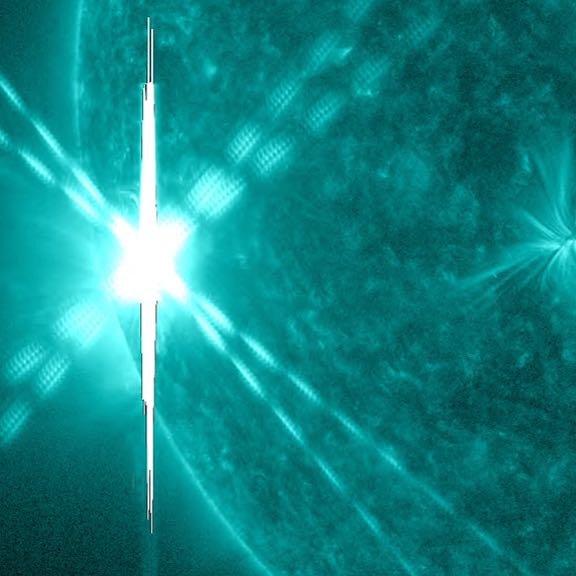On New Year’s Eve 2023, the sun blasted a huge X flare, the biggest of solar cycle 25 so far. It came from sunspot region AR3536 and measured X5 on the solar flare intensity scale. The eruption produced a wave that rippled across the sun’s face in all directions. It produced a coronal mass ejection, or CME, a great clump of superheated matter that left the sun and traveled outward into our solar system.
At first, experts thought this material would strike Earth a glancing blow, possibly causing a display of the aurora borealis or northern lights. But then it missed us entirely.
So what is an X flare? And can X flares harm us here on Earth?
Visit EarthSky’s daily sun news post

The 2024 lunar calendars are here! Makes a great New Years gift. Check ’em out here.
What are X flares?
Flares on the sun often happen in places where there are dark areas called sunspots. That’s where the sun’s magnetic fields are strongest and most complex.
Scientists classify flares according to their strength. The smallest ones are B-class, followed by C and M. X flares are the largest category of solar flares.
The biggest X-class flares are by far the largest explosions in our solar system. NASA says:
Made visible to us by sun-observing satellites, these solar flares are awesome to watch. Loops of solar material – called plasma – leap off the sun’s surface and expand to 10 times the size of Earth. The biggest flares can produce as much energy as a billion hydrogen bombs
The frequency of solar flares waxes and wanes in an 11-year cycle. And the sun is currently moving towards another solar maximum. The peak of the current cycle is now being predicted for this year, 2024.
So we can expect more X flares as this year progresses.

The Halloween solar storms
A particularly strong group of solar storms – which occurred from mid-October to early November in the year 2003 – produced the most powerful solar flare ever recorded by humans.
It was during the peak of another 11-year solar cycle. The sun was producing many solar flares and coronal mass ejections. On October 28, 2003, a storm occurred that was so strong, it overwhelmed the detectors set up to observe solar flares. The sensors cut out at X28. But, due to saturation of the detectors, scientists knew it was really much stronger. They eventually modeled it to be as strong as X45.
The 2003 solar storms caused satellite communications blackouts. They caused localized power outages in Sweden. They became known as the Halloween solar storms. The Solar and Heliospheric Observatory (SOHO) spacecraft captured this image of a that powerful X flare as it erupted from the sun in 2003.
Image via ESA.

The Carrington Event
Another famous solar storm – another X flare famous for its power – must have occurred in the year 1859. According to a 2016 study, on September 2, 1859, the British astronomer Richard Carrington saw the flare as a blast of white light on the sun’s surface. He later described it as:
… a singular outbreak of light which lasted about five minutes.
Afterwards, according to 2005 study, a report in the The Illustrated London News said that:
Sparks flew from telegraph machines in Paris.
The Washington Star in 1859 said that telegraph lines experiencing “a superabundance of electricity in the air” enabled telegraph machines to send messages from New York to Pittsburgh without the aid of batteries. They called it:
… One of the most startling as well as singular electrical phenomena.
Meanwhile, many parts of Earth experienced intense auroras. According to an 1859 report in the Weekly West newspaper, auroral displays were so bright that people in Missouri could read by them. The 2016 study said that people witnessed auroras as far south as the tropics, including in Cuba, Jamaica and Panama.
Many still speak of this event today. They call it the Carrington Event. Many wonder what would happen if a Carrington Event-sized flare happened today, in our our highly technological world that is so highly dependent on electricity.
M and X flares and their effects
Meanwhile, both B and C flares are too weak to affect Earth in any noticeable way.
Both M flares and X flares can cause brief radio blackouts on Earth. Plus, both M and X flares can release coronal mass ejections (CMEs). When CMEs do strike Earth, they disturb our planet’s magnetic field, often causing beautiful auroral displays. So aurora-watchers look forward to them!
But can X flares harm us? Generally speaking, the answer is no. Here on Earth’s surface, Earth’s atmosphere protects us from harm. Some people do say they notice effects from solar flaring, although – among scientists – these possible effects are still a matter for debate.
But – as with the 1859 Carrington Event, when earthly technologies were in their infancy – big CMEs have been known to interrupt communications satellites and power grids. NASA said:
That’s one reason NASA and NOAA – as well as others – constantly watch the sun to monitor for X-class flares and their associated magnetic storms. With advance warning, these scientists have a system for protecting many satellites and spacecraft from the worst effects of most magnetic storms.
As the current solar cycle – Solar Cycle 25 – reaches its peak, possibly in 2024, we can expect more X flares. Visit our sun sun post for daily updates.
Bottom line: X flares on the sun are the most powerful explosions in the solar system. We’re likely to see more of them as we approach solar maximum, due around 2025.











